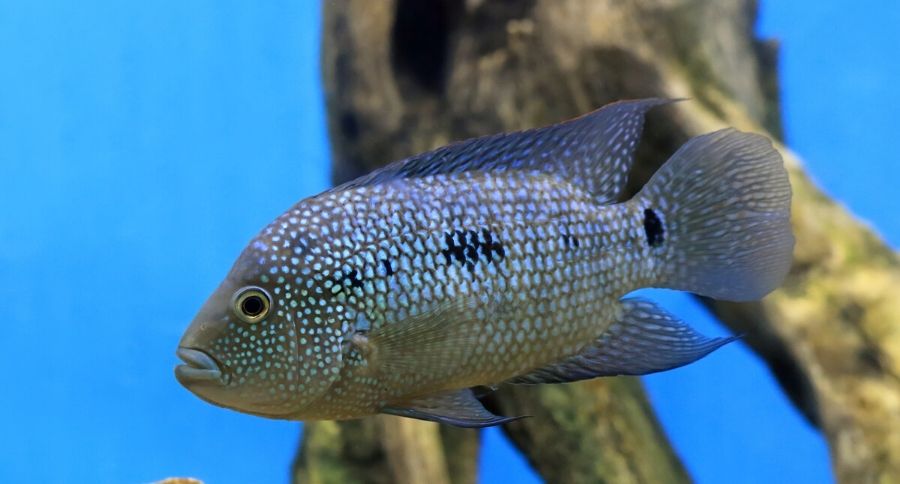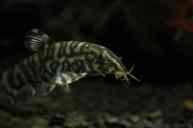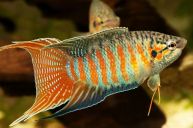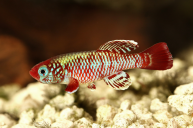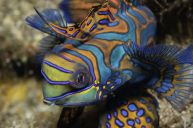This fish is not for beginners because their personality can be 'rough around the edges' and they also require a large tank! These are the only Cichlids that are naturally found in the United States and they're found in a part of the Rio Grande River in Texas and northern Mexico. This is why they are known as either Texas or Rio Grande Cichlids.
This fish is known as a large and aggressive fish that can reach up to a foot in length. If you have experience fish keeping the Texas cichlid or Pearl cichlid may be worth researching as they're loved for their beautiful appearance.
3 Cool facts about this fish
https://www.instagram.com/p/B6LgH17Junl/
- This fish has a 'violent temper' but Meet the Pet tells us many fishkeepers are huge fans of this breed regardless of their behavior.
- This cichlid can dwell both in warm and cold waters and is known to be highly adaptable.
- The average lifespan of this cichlid is 10 years, but it can live up to 15 years! This is a long time so you'll need to prepare for tankmates and the appropriate tank size for this fish.
Tank conditions
You need a large freshwater tank. How large? The minimum tank size is 55 gallons for a single specimen.
The Spruce Pets explains that you need an even larger tank if you plan to add other fish.
"When keeping Texas cichlids with other large fish, the tank should be 125 gallons or larger. Anyone who has kept this fish is well aware that attempting to craft a beautifully aquascaped tank is a losing battle because this fish is an avid digger that will uproot plants and move small rocks and other items of décor."
You must mimic their normal aquatic habitat. The substrate consists of sand combined with pebbles. You should also have some occasional plants and rocks scattered around the bottom.
Their preferred temperature is in the range of 71.5°F-77°F, so most tanks will require a heater. The pH should be kept in the range of 6.5-8.
There should be a lot of open space for these fish to swim around!
Typical behavior (what do they eat?)
https://www.instagram.com/p/B5rbG8fFCBC/
Our research had a common theme. This fish is absolutely not for beginners. It may demonstrate aggression towards its tankmates and can turn any nice tank into a mess. It also produces a lot of organic waste and as a result, requires a strong filter as well as frequent water renews.
As far as what to feed them it's fairly straight forward. The Texas cichlid is omnivorous and needs meaty foods balanced with vegetation. This includes live, frozen, flake, and pelleted foods. Provide live foods when possible, such as worms and insects or insect larvae.
Tankmates
Tankmates should include large species of fish that are capable of fending for themselves. The Spruce Pets tells us that when spawning these aggressive fish shouldn't be kept with any other fish.
"When spawning, they should not be kept with any other fish, as they are quite likely to kill any other fish in the tank. This is true of even their own species, as spawning pairs are highly aggressive."
The bottom line is these beautiful cichlid fish should be added to your tank if you have a lot of fish keeping experience.
Usually, Texas Cichlid has an unusual dotted pattern. It consists of differently sized spots that usually vary in color from green to light blue. As far as coloration, the body itself will often be dark or light green. Blue Texas cichlid, green Texas cichlid, and red Texas cichlid are all hybrids and available for sale.
Other common names include Pearl cichlid, Rio Grande cichlid, Rio Grande perch, and Texas cichlid. When doing your research look at these names too along with their scientific name, Herichthys cyanoguttatus.
These freshwater fish need a high-quality tank environment and their water temperatures are important to pay attention too so always watch for water changes and keep an eye on water conditions throughout the week. The environment should mimic their natural habitat. This fish species is high maintenance and you need to know what you're doing. Feed them brine shrimp!
WATCH NOW: Betta Fish Are Super Colorful!
